
Colebrookdale Green Cast-Iron Garden Seat from John Williams Collection
A Colebrookdale design green-painted cast-iron garden seat, Provenance: The Collection of John Williams Sydney Sold Christies Sydney. Dimensions: 130 cm wide 44 cm deep 82 cm high

Coalbrookdale Style Cast Iron Wrap Around Tree Bench with Grapevine
A 20th century Coalbrookdale style cast iron wrap around tree bench, the base of four fitted sections supported by eight legs, the centre decorated with trailing grape vines. 150 x 88 cm. (requires attention).

19th Century Coalbrookdale 'Fern' Cast Iron Garden Seat
Coalbrookdale (attributed) 'Fern' pattern antique cast iron garden seat, 19th century, 142 cm across the arms

Victorian Coalbrookdale Outdoor Table with Queen Victoria Medallions
A Victorian Coalbrookdale cast iron outdoor table, mid 19th century, the pierced table with undertier and Queen Victoria portrait profile medallions, impressed 'Coalbrookdale', with registration number to the inner skirt, 72 cm high, 60 cm diameter

Victorian Coalbrookdale Nasturtium Pattern Cast Iron Bench
A Victorian Coalbrookdale painted cast iron bench, 19th century, in Nasturtium Pattern introduced in 1875, stamped 'Coalbrookdale', 92 cm high, 180 cm wide, 67 cm deep

Victorian Cast Iron Garden Chairs
Two Victorian Coalbrookdale cast iron garden chairs, 19th century, serpent and Grape' pattern, painted red and dark green, with wooden slatted seats and backs, the end supports with dog head terminals on the arm rests, above scrolling snakes, stamped (2)…

Victorian Cast Iron Garden Set with Serpent & Grape Pattern
Victorian Coalbrookdale cast iron garden set, 19th century, serpent and Grape' pattern, painted black, comprising a table and two benches, the benches with wooden slatted seats and backs, the end supports with dog head terminals on the arm rests, above…

Green Cast Iron Garden Set, Early 20th Century
A three-piece green cast iron garden set, early 20th century, the cast iron Coalbrookdale style garden set including two chairs and one table, with green paint patina, height 65 cm, diameter 65 cm (table)

Coalbrookdale Fern Pattern Garden Furniture Set
Coalbrookdale style 'Fern' pattern cast metal garden seat and two armchairs (one cast-iron), 19th and 20th century, the settee 151 cm across the arms

19th Century Fern Pattern Cast Iron Garden Chairs
Coalbrookdale 'Fern' pattern pair of cast iron garden chairs, 19th century, 90 cm high, 65 cm across the arms

Victorian Coalbrookdale Garden Bench, 'Nasturtium' Pattern
Victorian cast iron garden bench, Coalbrookdale foundry, second half 19th century, 'Nasturtium' pattern, painted white with later wooden slate seat, stamped 'C.B.Dale' and numbered, with diamond patent marks, restored, height 100 cm width 186 cm depth 66…

Coalbrookdale Horse Chestnut Garden Bench
Victorian cast iron garden bench, Coalbrookdale foundry, second half 19th century, 'Horse Chestnut' pattern, painted black with later wooden slate seat, stamped 'Coalbrookdale' and numbered, with diamond patent marks, height 85 cm width 180 cm depth 60 cm…

19th Century Coalbrookdale Cast Iron Garden Chair
Coalbrookdale 'Four seasons, Harvest' antique English cast iron garden chair, 19th century, diamond pattern registration mark to back, 100 cm high

Victorian Coalbrookdale Iron Table and Chair Set
A Victorian Coalbrookdale cast iron table and chair, 19th century, the table 75 cm high, 55 cm diameter

White High Back Cast Iron Chairs - Coalbrookdale Style
A pair of cast iron high back chairs, Coalbrookdale style, white paint finish, height 95.5 cm.

Victorian Coalbrookdale Outdoor Suite with Fern Pattern
Victorian Coalbrookdale outdoor suite late 19th century fern pattern, black painted cast iron with wooden slats, comprising a bench and a pair of armchairs (3), height 86 cm, width 150 cm, depth 60 cm, (bench); height 91 cm, (chair). Provenance: Private…

Coalbrookdale Cast Iron Table Base with Glass Top
Coalbrookdale cast iron table base with later glass top, 61.5 x 61.5 cm, 71 cm high

Coalbrookdale 3 Piece Cast Iron Seating Set
Coalbrookdale 3 piece cast iron seating set comprising of a 2 seater 148 cm wide, 90.5 cm high and 2 single seat chairs 65 cm wide, 90.5 cm high

Black Serpent & Oak Leaf Cast Iron Garden Bench
Coalbrookdale style cast iron garden bench seat, in serpent and oak leaf pattern, in a black painted finish, length 126 cm
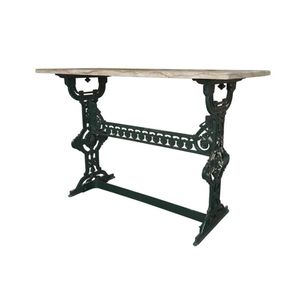
Green Cast Iron Garden Table with Stone Top
Coalbrookdale style green painted cast iron garden table, early 20th century, in the manner of Christopher Dresser, the rectangular white stone top above two cast supports joined by stretches, height 80 cm, width 122 cm, depth 51 cm. Provenance: The…
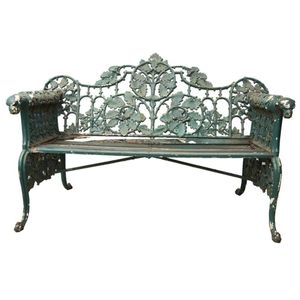
Green Cast Iron Garden Bench with Hound's Head Arms
Attributed to Coalbrookdale, green painted cast iron garden bench, early 20th century, 'Oak Leaf' pattern, arms terminating in hound's heads, wooden slats, one slat (A/F), height 100 cm, width 150 cm, depth 82 cm. Provenance: The Estate of Judith Hoyle,…

Green Cast Iron Garden Bench and Armchair Set
Coalbrookdale style green painted cast iron garden bench, early 20th century, 'Fern' pattern, wooden slats, together with matching armchair (2), height 91 cm, width 183 cm, depth 56 cm, height 89 cm, (chair). Provenance: The Estate of Judith Hoyle,…

Victorian Lily of the Valley Cast Iron Garden Chairs
Victorian cast iron garden chairs, Coalbrookdale foundry, second half 19th century, 'Lily of the Valley' pattern, seats and backs cast with flowers and leaves, reverses stamped with registration kite marks and numbered (2), height 86 cm. Provenance: The…
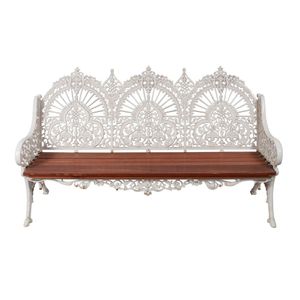
Indian-Inspired White Cast Iron Bench with New Slats
Coalbrookdale bench cast iron circa 1860, strong Indian influenced design, three arch painted white, with new slats, height 100 cm, length 172 cm, depth 65 cm

Victorian Convolvulus Cast Iron Garden Bench
Victorian cast iron Coalbrookdale garden bench seat, convolvulus pattern, 1850 cm wide, 850 cm high, 570 cm deep

Victorian Convulvulus Cast Iron Garden Bench
Victorian cast iron Coalbrookdale garden bench seat, convulvulus pattern, 1850 cm wide, 850 cm high, 570 cm deep

19th Century White Cast Iron Garden Set
A Coalbrookdale style garden table and three chairs, white painted cast iron, 19th century, the table 66 cm high, 53 cm diameter

Victorian Cast Iron Chairs Set
A set of six cast iron Coalbrookdale style chairs, ornate Victorian design with circular seats.

Early 20th Century Cast Iron Tripod Tables
A pair of early 20th century cast iron tables, tripod design, possibly Coalbrookdale.

Coalbrookdale Fern & Blackberry Garden Chairs (1870)
A pair of Coalbrookdale fern and Blackberry pattern garden chairs, English circa 1870. 94 x 65 x 55 cm each
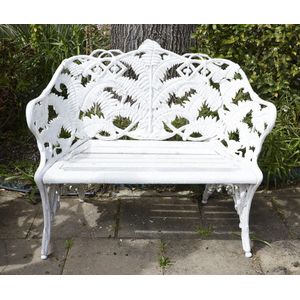
Antique Coalbrookdale Garden Bench, 1870
A Coalbrookdale cast iron two seater garden bench, fern and blackberry pattern, stamped 'C.B.Dale & Co.' with a registration mark. Circa 1870. Width 108 cm

C.B.Dale Garden Bench with Fern & Blackberry Motif
A Coalbrookdale style garden bench, fern and blackberry motif, stamped 'C.B.Dale' to the back. Wooden slat seat.

C. Brookdale Garden Seat: Rustic Faux Bois Design
Coalbrookdale garden seat mid 19th century, c1860, English, cast iron, rustic, faux Bois an vine design, original spiral Struts, design No.78766, height 88 cm, length 128 cm, depth 61 cm

Coalbrookdale Style Bench Seat with Timber and Metal
A Coalbrookdale style timber & metal bench seat

Refurbished Coalbrookdale Style Outdoor Chairs - Resprayed
A pair of Coalbrookdale style outdoor chairs, refurbished & resprayed

19th Century Coalbrookdale Fern Garden Seat
A Coalbrookdale Fern pattern garden seat, cast iron and timber, English, 19th century, 161 cm across the handles

Coalbrookdale Fern Garden Seat, 19th Century
A Coalbrookdale Fern pattern garden seat, cast iron and timber, English, 19th century, stamped 'Coalbrookdale' on the front iron rail, 184 cm across the arms

Victorian Cast Iron Garden Seat in Coalbrookdale Style
A Victorian cast iron outdoor garden seat, in the Coalbrookdale manner, matching the above bench seat. Provenance: Douglas Wright Estate.
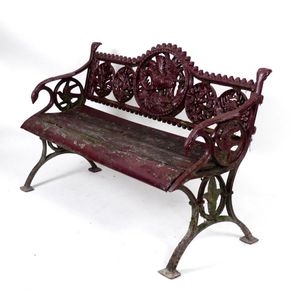
Victorian Cast Iron Garden Bench with Hunting Dog Design
A decorative Victorian cast iron garden bench seat in the manner of Coalbrookdale, the back panel with a hunting dog amongst ferns and florals and an oval panel flanked by two further floral decorated panels, bird decorated arms, curving five panel wood…

Victorian Cast Iron Garden Seat with Serpent and Grapes
A Victorian Coalbrookdale 'Serpent and Grapes' pattern cast iron garden seat, each end cast with a dog's head terminal to the armrest above a support of an entwined serpent and fruiting grape vine, the ends now painted green, the design number 17597 and…

Coalbrookdale Fern and Blackberry Bench
A Coalbrookdale 'Fern and Blackberry' bench in the 'fern and Blackberry' pattern, wooden seat, painted white. Stamped C.B Dale & Co, no. 113617, no. 29. Registration mark: July 1873. Wooden seat.

Coalbrookdale Fern and Blackberry Bench
A Coalbrookdale 'Fern and Blackberry' bench in the 'fern and Blackberry' pattern, wooden seat, painted white. Stamped C.B Dale & Co, no. 113617, no. 29. Registration mark: July 1873. Wooden seat.

Coalbrookdale White Fern & Blackberry Bench
A Coalbrookdale 'Fern and Blackberry' bench in the 'fern and Blackberry' pattern, wooden seat, painted white. Stamped C.B Dale & Co, no. 113617, no. 29. Registration mark: July 1873. Wooden seat.

Coalbrookdale-style Pub Table with Marble Top
A Coalbrookdale style cast iron pub table with white marble top. Height 68 cm, diameter 66.5 cm

Coalbrookdale Style Pub Table with Marble Top
A Coalbrookdale style cast iron pub table with white marble top. Height 68 cm, diameter 66.5 cm

White Fern and Blackberry Cast Iron Garden Chair
A Coalbrookdale cast iron garden chair in the 'fern and Blackberry' pattern, wooden seat. Painted white.

Coalbrookdale Cast Iron Hall Chairs by Dresser (1870)
A pair of Coalbrookdale cast iron hall chairs designed by Christopher Dresser c.1870 in the 'Lily' pattern, the decorative backs with a combination of fluted, fan and wrythen forms, conforming base, the cast iron seats with enamelled dark red brown button…

Tree Form Coalbrookdale Garden Bench with Black and Green Finish
Coalbrookdale garden bench with tree form ends and two wooden slats, in a black and green finish

Black and Green Coalbrookdale Garden Bench
Coalbrookdale cast iron garden bench in black and green finish

White Metal Outdoor Dining Set
A white painted Coalbrookdale style cast metal set of chairs and a round table, 20th century the table, 66 cm high, 69 cm diameter

White Marble Iron Tables and Armchairs Set
A pair of white painted Coalbrookdale style rectangular marble topped wrought iron tables and a set of twelve armchairs, 20th century, the tables each 72 cm high, 122 x 96 cm

Victorian Cast Iron Fern & Blackberry Furniture Set
A suite of Victorian cast iron fern & Blackberry furniture, probably Coalbrookdale foundry, comprising, bench and two chairs, Victorian lozenge registration mark to the back of the bench and fain mark to front bar, (3). Provenance: The collection of…

Aluminium Garden Set: Chairs & Table (3 pieces)
Coalbrookdale style aluminium garden chairs & table, table approx 64 cm high, 71 cm diameter (3)

Victorian Coalbrookdale Cast Iron Settee with Break
Victorian cast iron Coalbrookdale settee, with old break in back centre, the detached piece sits in place of it's own accord, 126 cm wide. 97 cm high

Rare Coalbrookdale Medallion Cast Iron Bench
A Victorian cast iron bench by Coalbrookdale, in a rare 'Medallion design', with cast back depicting allegorical figures in oval plaques, with mask to crest, marked Coalbrookdale to front and with lozenge mark and 5F to the back

Coalbrookdale Fern & Dog Cast Iron Bench
A Victorian cast iron 'Fern & dog' bench by Coalbrookdale, with a cast panel to back depicting a hunting dog, the arms with birds

Coalbrookdale Horse Chestnut Bench
A Victorian cast iron 'Horse Chestnut' bench by Coalbrookdale, in typical design with slatted seat

Coalbrookdale Lily of the Valley Garden Bench
cast iron framed garden bench 'Lily of the Valley' Coalbrookdale, of naturalistic form depicting anthemion lily design with slatted seat, 185 cm width

Victorian Coalbrookdale Garden Bench with Wooden Settee
A Victorian Coalbrookdale garden bench, fern pattern, with wooden settee. Width 148 cm. Restorations

Green Cast Iron Garden Settee - Victorian Era
A Victorian Coalbrookdale green painted cast iron garden settee, 1470 cm long

Victorian Cast Iron Garden Chairs (Pair)
Pair of Victorian painted cast iron garden chairs. Possibly Coalbrookdale, each with pierced decoration to the back and seat, the round back decorated with a central medallion depicting a peasant, raised on richly cast cabriole legs surmounted by…

Victorian Cast Iron Garden Bench - 178 cm Length
A Victorian Coalbrookdale cast iron garden bench. Length of back 178 cm

Set of 6 Cast Metal Garden Chairs in Coalbrookdale Style
Set of six cast metal Coalbrookdale style garden chairs (6)

Coalbrookdale Park Bench with Nasturtium Trellis Design
An early 20th century cast iron Park bench stamped Coalbrookdale, with wooden slats, the back and sides cast with a trellis of Nasturtium leaves, 177.5 cm wide

Pair of Coalbrookdale Nasturtium Cast Iron Garden Seats
Coalbrookdale 'Nasturtium' pattern, pair of cast iron garden seats, stamped C.B.Dale Co No.195629 and with diamond design patent registration stamp beneath the central cresting at the front, further stamped No. 44 beneath, and with Coalbrookdale stamped…

Coalbrookdale Cast Iron Garden Seats with Seasonal Medallions
A pair of cast iron garden seats attributed to Coalbrookdale, each with a medallion back, cast with a representation of the seasons summer and spring respectively

Seasonal Cast Iron Garden Bench
A cast iron framed garden bench attributed to Coalbrookdale, the back cast with four medallions depicting figural representations of the four seasons, within a pierced foliate cast surround, 184 cm wide

Coalbrookdale Chestnut Bench - Restored and Registered
A Coalbrookdale cast iron horse Chestnut bench, with registration mark and seat number, replacement bolts and weak seat planks, recoated, 186 cm width

19th Century English Cast Iron Garden Table with Marble Top
A Colebrookdale cast iron garden table with marble top, English, late 19th century, 72 cm high, 87 cm wide and 44 cm deep

Victorian Marble and Iron Conservatory Table
A Victorian cast-iron English Coalbrookdale conservatory table. Circular form, with an inset marble top within foliate decoration, on a foliate decorated column, with a flared base. 77 cm high, 59 cm wide.

Coalbrookdale Style Cast Iron Bench and Table Ends
A pair of Coalbrookdale style cast iron bench ends and table ends





 Loading more...
Loading more...